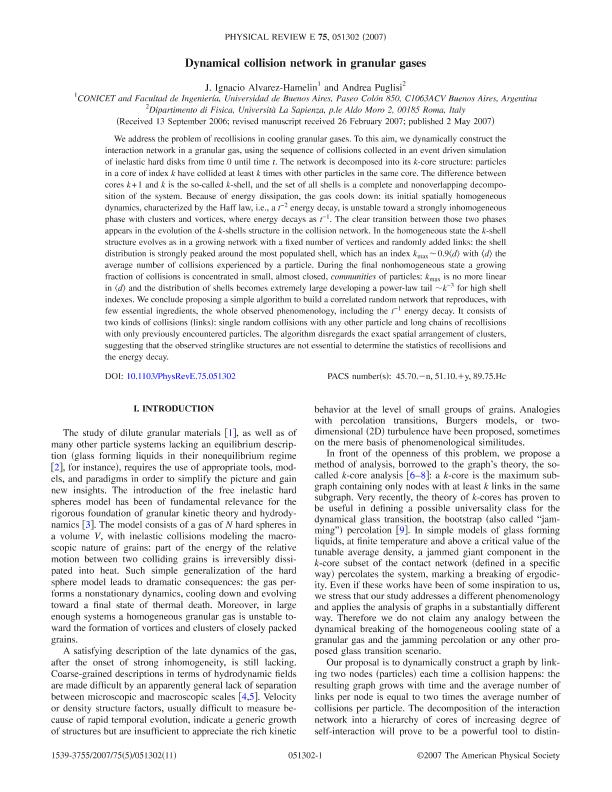Artículo
The dynamical collision network in granular gases
Fecha de publicación:
05/2007
Editorial:
American Physical Society
Revista:
Physical Review E: covering statistical, nonlinear, biological, and soft matter physics
ISSN:
2470-0045
e-ISSN:
2470-0053
Idioma:
Inglés
Tipo de recurso:
Artículo publicado
Clasificación temática:
Resumen
We address the problem of recollisions in cooling granular gases. To this aim, we dynamically construct the interaction network in a granular gas, using the sequence of collisions collected in an event driven simulation of inelastic hard disks from time
0
until time
t
. The network is decomposed into its
k
-core structure: particles in a core of index
k
have collided at least
k
times with other particles in the same core. The difference between cores
k
+
1
and
k
is the so-called
k
-shell, and the set of all shells is a complete and nonoverlapping decomposition of the system. Because of energy dissipation, the gas cools down: its initial spatially homogeneous dynamics, characterized by the Haff law, i.e., a
t
−
2
energy decay, is unstable toward a strongly inhomogeneous phase with clusters and vortices, where energy decays as
t
−
1
. The clear transition between those two phases appears in the evolution of the
k
-shells structure in the collision network. In the homogeneous state the
k
-shell structure evolves as in a growing network with a fixed number of vertices and randomly added links: the shell distribution is strongly peaked around the most populated shell, which has an index
k
max
∼
0.9
⟨
d
⟩
with
⟨
d
⟩
the average number of collisions experienced by a particle. During the final nonhomogeneous state a growing fraction of collisions is concentrated in small, almost closed, communities of particles:
k
max
is no more linear in
⟨
d
⟩
and the distribution of shells becomes extremely large developing a power-law tail
∼
k
−
3
for high shell indexes. We conclude proposing a simple algorithm to build a correlated random network that reproduces, with few essential ingredients, the whole observed phenomenology, including the
t
−
1
energy decay. It consists of two kinds of collisions (links): single random collisions with any other particle and long chains of recollisions with only previously encountered particles. The algorithm disregards the exact spatial arrangement of clusters, suggesting that the observed stringlike structures are not essential to determine the statistics of recollisions and the energy decay.
Palabras clave:
Granular
,
Networks
,
Statistic
Archivos asociados
Licencia
Identificadores
Colecciones
Articulos(INTECIN)
Articulos de INST.D/TEC.Y CS.DE LA ING."HILARIO FERNANDEZ LONG"
Articulos de INST.D/TEC.Y CS.DE LA ING."HILARIO FERNANDEZ LONG"
Citación
Alvarez Hamelin, José Ignacio; Puglisi, Andrea; The dynamical collision network in granular gases; American Physical Society; Physical Review E: covering statistical, nonlinear, biological, and soft matter physics; 75; 5; 5-2007; 5130201-5130211
Compartir
Altmétricas




